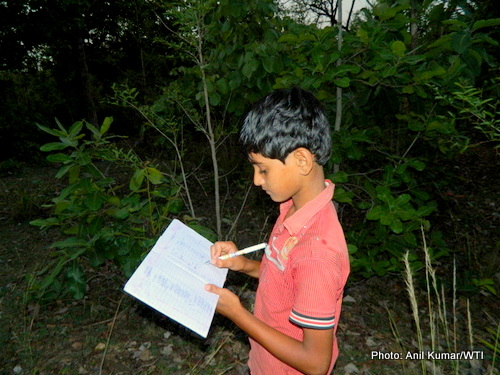Children and youth in rural areas often wander into the nearby forests either for fun, pleasure or the curiosity to explore. “During these excursions, they come across interesting information which is sometimes shared with family and villagers, but mostly they keep it to themselves due to the fear of being reprimanded by adults for venturing into areas that are labelled as dangerous,” said Anil Kumar, who is working closely with the community as a sociologist on WTI’s project
For conservation purposes, this information could prove to be vital in the management and protection of forests and protected areas. Keeping this in mind, WTI decided to enrol some of these children as Village Wildlife Watchers for such an initiative. The team zeroed down on students who had participated in IFAW-WTI’s Animal Action Education (AAE) programme in the corridor villages and schools in 2014. Three school boys and one youth volunteered to document wildlife related information which they would encounter while walking around agriculture fields, villages and forest area. Finally, the activity got a head start on November 14, 2015, celebrated across India as Children’s Day.
Devendra Bhonde, a temporary help working for a railway contractor, manages the unmanned railway crossing between Garada and Sondlagondi. Participant of the rangoli contest in 2014 when he created ‘a tiger in the forest’ on the floor of a school using powdered colours, this young man often encounters wild animals crossing the railway tracks. He willingly came forth to document information on wildlife and its frequency of crossing the tracks. “Since November 2015, he has been taking note of wild animals crossing the tracks so that mitigation measures can be suggested to the railways. After electrification of the railway line, we expect trains to pass this stretch at high speed,” added Anil.

Pankaj Bopache from Jhambulpani village collecting data
“It’s a way of motivating the next generation to become stakeholders in conserving wildlife. If it works out the way we have envisaged, then by the year end, we can see the trends of animal movement in the corridors. We could see if there is a trend and whether animal movement is high in certain areas or during certain months. These kids can be our eyes in these corridors. Also, we would not do occupancy surveys every now and then and this information can fill the gaps,” said Dr Rahul Kaul, Chief Ecologist, WTI.